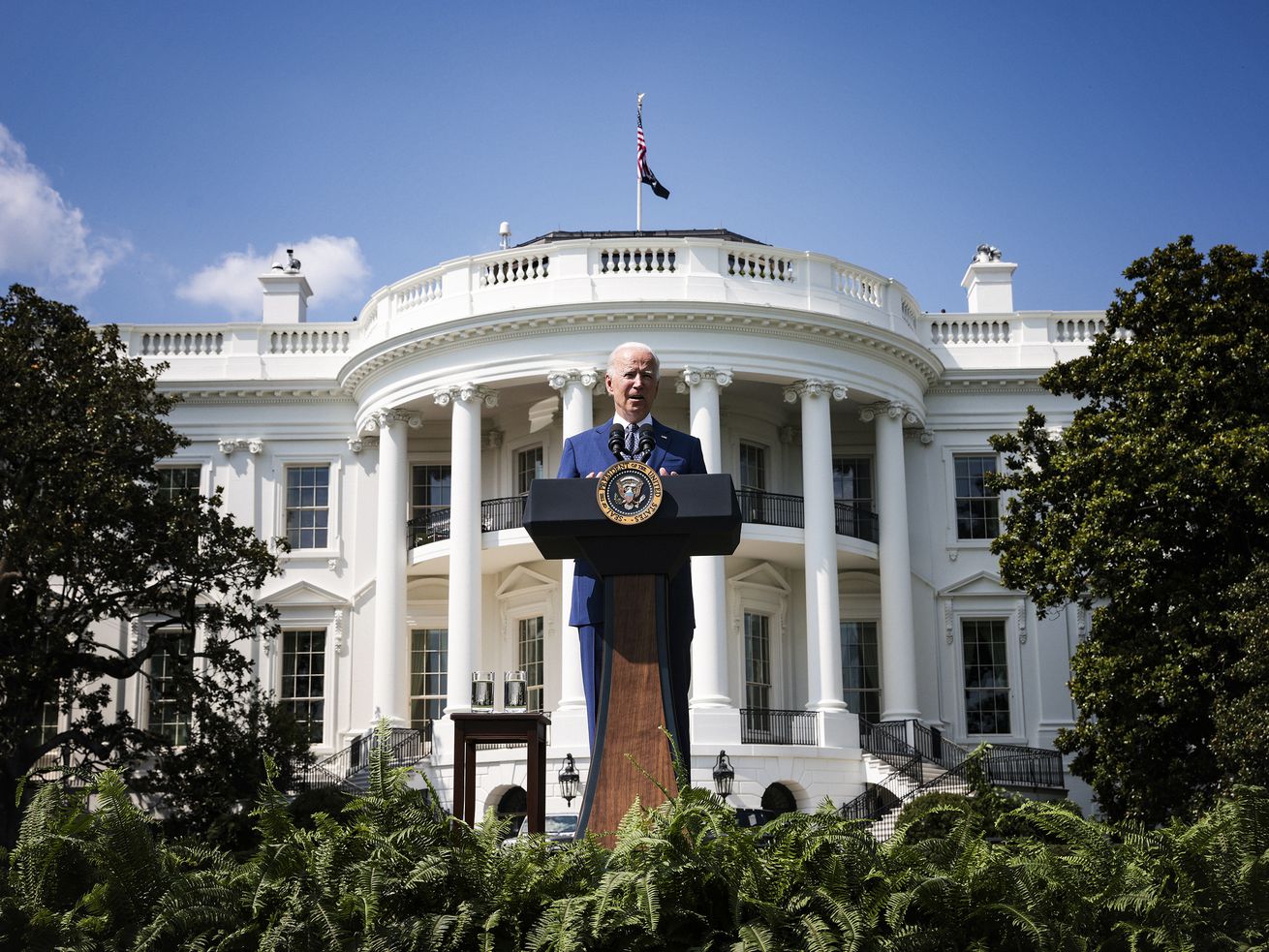Democrats’ massive spending plan, explained.
Democrats are moving ahead on what could be the most consequential piece of domestic policy legislation in decades, and the planned centerpiece of President Joe Biden’s first-term agenda.
This coming megabill doesn’t yet have a name. It hasn’t technically been written. But on Monday, Senate Democrats released their current plan for what to put in it — and, well, it’s a whole lot.
Low-income families would get what’s effectively a “child allowance” — money to help raise kids — for longer, via an expanded child tax credit. Seniors on Medicare would get new dental, vision, and hearing benefits, as well as lower prescription drug prices. The coming bill would create new programs for universal pre-K, subsidized child care, free community college, and paid family leave. Some unauthorized immigrants would be able to get green cards. Then there’s major spending on clean energy, housing affordability, and much more.
It would be “the most consequential piece of legislation passed since the Great Depression,” Sen. Bernie Sanders (I-VT) said last month. In spending terms, it would be as much as $3.5 trillion — about triple the size of Obamacare, the law that then-vice president Biden famously called “a big fucking deal.”
/cdn.vox-cdn.com/uploads/chorus_asset/file/22766998/GettyImages_1322582771_copy.jpg) Alex Wong/Getty Images
Alex Wong/Getty ImagesThe sheer range of issues the bill will cover is dizzying: It’s practically everything in Democrats’ domestic policy agenda that Senate rules would permit them to pass without any Republican support, via the special, filibuster-proof budget reconciliation process.
There’s a long road ahead, though. Moderates like Sens. Joe Manchin (D-WV) and Kyrsten Sinema (D-AZ) will likely force alterations, or could even scuttle the whole thing (Sinema has said that she wants less spending). The Senate parliamentarian could rule some provisions out of order, throwing them out of the bill. Raising enough revenue to cover the bill’s costs, as moderates are demanding, may also be controversial and result in further cuts. So yes, there’s still a lot of uncertainty about what this will look like, or whether it will pass at all, with many details unsettled.
But as of now, top Democrats are aiming for a transformational bill that could enormously affect many Americans’ lives — from parents to community college students to the poor to anyone concerned about the planet. This is how it would do so.
It would give people money
The megabill would put more money in American families’ pockets, especially the very poor. The main way it would do so is through tax credits — taking temporary policies that were meant to help families during the pandemic and extending them for several more years.
The centerpiece is the expanded child tax credit, which, since last month, goes out in monthly payments (to the joy of many parents), making it essentially a “child allowance” — a government payment for families with children. The benefit is also, for now, significantly bigger (for all families except the rich), and available to poor families, including those earning no taxable income at all.
/cdn.vox-cdn.com/uploads/chorus_asset/file/22766991/GettyImages_1233996057_copy.jpg) Frederic J. Brown/AFP via Getty Images
Frederic J. Brown/AFP via Getty ImagesThis latter part especially is a big deal, since the poorest of the poor need the money the most, and nonworkers had been so often left out of previous policies. Although there are definite implementation challenges at getting the money to those who need it most, if those could be overcome it would be transformational for many poor familes, and anti-poverty crusaders and social policy wonks have been tremendously excited about it.
The catch is that this expansion was temporary — the child tax credit is set to revert back to normal after 2021. Democrats’ megabill would extend the supersized version for at least somewhat longer. It would do the same for other temporarily expanded tax credits: the earned income tax credit and the child and dependent care tax credit. Democratic aides hope that, in practice, this will mean a permanent expansion, because once these are in effect for a few years, they will be too politically popular for Congress to let them expire.
It would help with child-raising expenses, from birth to college
The megabill would have the federal government do far more to support parents, providing money or establishing new programs related to child care, pre-K, community college, and more.
For all of these, the exact details about how they will work remain to be determined and are subject to change, but Democrats have indicated they would spend large sums of money on each of these priorities:
- Paid leave: Currently, the federal government does not guarantee paid leave for working parents. Some states require it, and some employers voluntarily offer it — but small businesses and employers with few high-wage workers are less likely to do so. So the megabill would create a national paid leave program, in which the government would pay part of a worker’s salary for up to 12 weeks of leave (for new parents or other issues, such as serious illness). As Matt Yglesias wrote earlier this year, under Biden’s plan the government’s share of these leave payments would be capped at $4,000 a month, so in practice, this would be most useful for low-wage workers.
- Child care subsidies: The bill would also try to help low- and middle-income families with the cost of child care. Basically, if you earn below a certain amount, the federal government would help foot the bill for your child care — subsidizing it so that costs won’t exceed a certain percentage of your income. Many details remain to be worked out here, particularly Biden’s promise that the resulting child care will be “high quality,” which seems more challenging to implement.
- Funding pre-K: In much of the US, public schooling starts at age 5, with kindergarten, and many parents of 3- and 4-year-olds don’t have a government-funded option for pre-K. The bill would try to change this, allotting hundreds of millions of dollars for preschool expansion. This implementation would again have to happen at the state and local levels.
- Summer lunches for low-income children: Currently, low-income children can get free lunch at school, and Democrats want to extend that benefit to cover the summer when school is out — another anti-poverty measure.
- Free community college: The bill would fund Biden’s plan to cover two years of free community college to those who want it.
- Expanded Pell grants: Low-income students who rely on Pell grants to help pay for college would get extra help under this bill.
It’s a health care bill, especially for seniors
Even after Obamacare extended health insurance to millions more Americans, major gaps in the US’s system and the benefits it provides remain — gaps that frequently expose Americans to burdensome and even ruinous expenses. This year’s megabill is expected to fill several of those gaps:
- Medicare expansion to cover dental, vision, and hearing: The megabill would expand Medicare to cover dental, vision, and hearing benefits (which are mostly or entirely not covered in standard Medicare plans), meaning it could be a huge help to seniors who incur those expenses. The budget resolution also would allow for lowering the eligibility age for Medicare, but it is unclear at this point whether this will make it into the eventual bill.
- Medicare drug price negotiation: Democrats also plan to empower Medicare to negotiate with the federal government on prescription drug pricing, something that would drive prices down for seniors. It has the added benefit of driving costs down for the federal government, which would help pay for the megabill’s new spending.
- Long-term care: Democrats also hope to spend hundreds of billions of dollars on long-term care for seniors and people with disabilities who need daily assistance. As Jonathan Cohn writes, more than 800,000 Americans are on waiting lists for home and community-based care services right now, due to lack of funding.
- Medicaid expansion: There are still 12 states that have not implemented Obamacare’s expansion of Medicaid to more low-income people, and Democrats have committed to ensuring they get coverage in this bill — though they’re still debating how, exactly, to do it.
- Affordable Care Act subsidies: Finally, Democrats also intend to make temporary, pandemic-inspired expansions in subsidies for people getting health care on Obamacare’s individual marketplaces permanent.
It’s a climate, housing, and immigration bill — for now, at least
Democrats are also using this bill as the vehicle for their climate change agenda. The catch is that the bill will have to win the approval of coal-state Sen. Joe Manchin, so don’t expect a frontal assault on fossil fuels. But Democrats remain hopeful that measures to support clean energy can win Manchin over.
Current plans are to include:
- A clean electricity payment program: The marquee climate policy in this bill would be a call for 80 percent of the US’s electricity to be generated by clean sources by 2030, according to E&E News. The bill likely can’t directly mandate this due to restrictions in the reconciliation process. But it will try to achieve it by making payments to utilities that rely on clean energy, while fining those that aren’t making progress toward reducing carbon emissions, as my colleague Rebecca Leber recently explained. Manchin will play a big role in crafting this, as he chairs the key Senate committee that will be involved.
- Clean energy tax incentives and research money: Renewable energy industries like wind and solar would get big tax breaks, and a “clean energy accelerator” would be funded to support new technologies.
- Polluter import fee and methane polluter fee: The idea for an outright “carbon tax” is long dead, but Democrats have proposed putting tariffs on imported goods from countries with weaker restrictions on carbon emissions, and putting a price on methane emissions (which heavily contribute to climate change).
Other issues the bill may tackle:
Housing: Democrats plan to allot hundreds of billions of dollars more for affordable housing, with money going to rental assistance and homeownership initiatives, as well as the “creation and preservation of affordable housing.”
Immigration: Finally, though details remain scarce, Democrats are currently saying they intend to include in the megabill a path to legal status for some undocumented immigrants. Sen. Bob Menendez (D-NJ) told NBC News last month this would apply to some of each of the following categories: those who came here as children, farmworkers, people with Temporary Protected Status, and essential workers.
Yet there is a potential issue. The Senate parliamentarian will have to rule on whether immigration measures like this are truly eligible for budget reconciliation (the special process Democrats are using to pass this bill). Only policies with a clear impact on the federal budget are eligible to be included, and though some have argued that a path to citizenship would qualify, it’s not clear whether parliamentarian Elizabeth McDonough will agree. President Biden has indicated that Democrats will respect her ruling.
What’s next for the process
The megabill does not yet, technically speaking, exist. But last month, Democrats on the Senate Budget Committee reached a deal on how much money the forthcoming megabill will spend overall, and in various areas. To do so, they came to a de facto agreement on what they hope to put in it.
The next step is for the full Senate to approve this deal by passing a budget resolution this week, and for the House to do the same later this month. Doing this unlocks the filibuster-proof budget reconciliation process.
After that, both chambers can finally get around to actually hammering out the details of the megabill itself. Democrats hope to pass it and get it signed into law by President Biden by the end of the year.
Changes to the overall bill are likely at every step of this process. But the budget resolution is the first step; it sets the stage for everything that will come later. And Democrats have made clear that they are starting with very lofty ambitions indeed.
Author: Andrew Prokop
Read More



